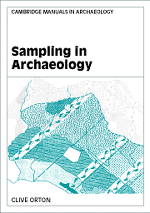Book contents
- Frontmatter
- Contents
- List of illustrations
- List of tables
- Acknowledgements
- 1 All the world's a sample
- 2 A little of what you fancy?
- 3 If this is the sample, what was the population?
- 4 Covering the ground
- 5 What's in a site?
- 6 The answer lies in the soil
- 7 ‘But many sanguine people hope, to see them through a microscope’
- 8 ‘In its depths, what treasures’
- 9 Beyond random sampling
- Appendix
- Bibliography
- Index
7 - ‘But many sanguine people hope, to see them through a microscope’
Published online by Cambridge University Press: 05 June 2012
- Frontmatter
- Contents
- List of illustrations
- List of tables
- Acknowledgements
- 1 All the world's a sample
- 2 A little of what you fancy?
- 3 If this is the sample, what was the population?
- 4 Covering the ground
- 5 What's in a site?
- 6 The answer lies in the soil
- 7 ‘But many sanguine people hope, to see them through a microscope’
- 8 ‘In its depths, what treasures’
- 9 Beyond random sampling
- Appendix
- Bibliography
- Index
Summary
Introduction
In this chapter we consider the smallest of the scales at which sampling is undertaken in archaeology – that of sampling from artefacts or ecofacts for ‘scientific’ analysis, such as chemical, physical or textural analysis (p. 184). This process usually divides into two stages:
(a) the selection of objects (whether artefacts or ecofacts) from an assemblage,
(b) the selection of samples from the chosen objects themselves.
The aim is usually to estimate parameters, such as chemical compositions, isotopic ratios or grain size distributions, which will help to characterise the assemblage in some way, for example in determining its provenance(s), in dating it, or in providing information about manufacturing techniques.
The first stage is needed because assemblages can be very large, and the scientific techniques can be very expensive, or very time-consuming. A few examples may therefore have to represent a very large collection, for example in the characterisation of the products of a pottery production site, but the issues involved in ensuring that the sample is truly representative are rarely discussed, and often taken for granted. Even the question of sample size seems often to be determined by financial or time constraints rather than by any archaeological or statistical consideration. Frequently, it seems that inferences have to be drawn from very small samples about very large populations, which must make one very concerned about the cavalier or unthinking attitude that is sometimes taken towards the selection of such samples.
- Type
- Chapter
- Information
- Sampling in Archaeology , pp. 177 - 190Publisher: Cambridge University PressPrint publication year: 2000



